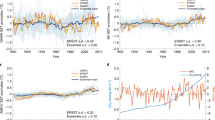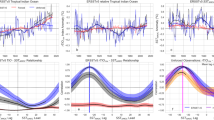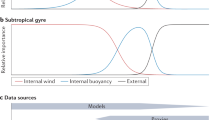Abstract
Predicting the evolution of climate over decadal timescales requires a quantitative understanding of the dynamics that govern the meridional overturning circulation (MOC)1. Comprehensive ocean measurement programmes aiming to monitor MOC variations have been established in the subtropical North Atlantic2,3 (RAPID, at latitude 26.5° N, and MOVE, at latitude 16° N) and show strong variability on intraseasonal to interannual timescales. Observational evidence of longer-term changes in MOC transport remains scarce, owing to infrequent sampling of transoceanic sections over past decades4,5. Inferences based on long-term sea surface temperature records, however, supported by model simulations, suggest a variability with an amplitude of ±1.5–3 Sv (1 Sv = 106 m3 s-1) on decadal timescales in the subtropics6. Such variability has been attributed to variations of deep water formation in the sub-arctic Atlantic, particularly the renewal rate of Labrador Sea Water7. Here we present results from a model simulation that suggest an additional influence on decadal MOC variability having a Southern Hemisphere origin: dynamic signals originating in the Agulhas leakage region at the southern tip of Africa. These contribute a MOC signal in the tropical and subtropical North Atlantic that is of the same order of magnitude as the northern source. A complete rationalization of observed MOC changes therefore also requires consideration of signals arriving from the south.
This is a preview of subscription content, access via your institution
Access options
Subscribe to this journal
Receive 51 print issues and online access
$199.00 per year
only $3.90 per issue
Buy this article
- Purchase on Springer Link
- Instant access to full article PDF
Prices may be subject to local taxes which are calculated during checkout





Similar content being viewed by others
References
Keenlyside, N. S., Latif, M., Jungclaus, J., Kornblueh, L. & Roeckner, E. Advancing decadal-scale climate prediction in the North Atlantic sector. Nature 453, 84–88 (2008)
Cunningham, S. A. et al. Temporal variability of the Atlantic meridional overturning circulation at 26.5° N. Science 317, 935–938 (2007)
Kanzow, T., Send, U., Zenk, W., Chave, A. D. & Rhein, M. Monitoring the integrated deep meridional flow in the tropical North Atlantic: Long-term performance of a geostrophic array. Deep-Sea Res. I 53, 528–546 (2006)
Bryden, H., Longworth, H. R. & Cunningham, S. A. Slowing of the Atlantic meridional overturning circulation at 25° N. Nature 438, 655–657 (2005)
Wunsch, C. Mass and volume transport variability in an eddy-filled ocean. Nature Geosci. 1, 165–168 (2008)
Latif, M. et al. Is the thermohaline circulation changing? J. Clim. 19, 4631–4637 (2006)
Böning, C. W., Scheinert, M., Dengg, J., Biastoch, A. & Funk, A. Decadal variability of subpolar gyre transport and its reverberation in the North Atlantic overturning. Geophys. Res. Lett. 33 doi: 10.1029/2006GL026906 (2005)
Gordon, A. L. Inter-ocean exchange of thermocline water. J. Geophys. Res. 91, 5037–5046 (1986)
Lutjeharms, J. R. E. The Agulhas Current (Springer, 2006)
Olson, D. B. & Evans, R. H. Rings of the Agulhas Current. Deep-Sea Res. A 33, 27–42 (1986)
De Ruijter, W. P. M. et al. Dynamics, estimation and impact of South Atlantic inter-ocean exchange. J. Geophys. Res. 104, 20885–20910 (1999)
Peeters, F. J. C. et al. Vigorous exchange between Indian and Atlantic Ocean at the end of the last five glacial periods. Nature 430, 661–665 (2004)
Weijer, W., de Ruijter, W. P. M., Dijkstra, H. A. & van Leeuwen, P. J. Impact of interbasin exchange on the Atlantic overturning circulation. J. Phys. Oceanogr. 29, 2266–2284 (1999)
Marsh, R., Hazeleger, W., Yool, A. & Rohling, E. J. Stability of the thermohaline circulation under millennial CO2 forcing and two alternative controls on Atlantic salinity. Geophys. Res. Lett. 34 doi: 10.1029/2006GL027815 (2007)
Van Leeuwen, P. J., de Ruijter, W. P. M. & Lutjeharms, J. R. E. Natal pulses and the formation of Agulhas rings. J. Geophys. Res. 105, 6425–6436 (2000)
Biastoch, A., Lutjeharms, J. R. E., Böning, C. W. & Scheinert, M. Mesoscale perturbations control inter-ocean exchange south of Africa. Geophys. Res. Lett. doi: 10.1029/2008GL035132 (in the press)
Biastoch, A., Böning, C., Getzlaff, J., Molines, J.-M. & Madec, G. Causes of interannual - decadal variability in the meridional overturning circulation of the mid-latitude North Atlantic Ocean. J. Clim. doi: 10.1175/2008JCLI2404.1 (in the press) (2008)
Debreu, L., Vouland, C. & Blayo, E. AGRIF: Adaptive grid refinement in Fortran. Computers Geosci. 34, 8–13 (2008)
Maltrud, M. E. & McClean, J. An eddy resolving global 1/10° ocean simulation. Ocean Model. 8, 31–54 (2005)
Johnson, H. L. & Marshall, D. P. A theory for the surface Atlantic response to thermohaline variability. J. Phys. Oceanogr. 32, 1121–1132 (2002)
Getzlaff, J., Böning, C. W., Eden, C. & Biastoch, A. Signal propagation related to the North Atlantic overturning. Geophys. Res. Lett. 32 doi: 10.1029/2004GL021002 (2005)
Dong, B. W. & Sutton, R. T. Adjustment of the coupled ocean-atmosphere system to a sudden change in the thermohaline circulation. Geophys. Res. Lett. 29 doi: 10.1029/2002GL015229 (2002)
Garzoli, S. L. et al. Three Agulhas rings observed during the Benguela Current Experiment. J. Geophys. Res. 104, 20971–20985 (1999)
Van Sebille, E. & van Leeuwen, P. J. Fast northward energy transfer in the Atlantic due to Agulhas rings. J. Phys. Oceanogr. 37, 2305–2315 (2007)
Van Aken, H. M. et al. Observation of a young Agulhas ring, Astrid, during MARE, the Mixing of Agulhas Rings Experiment, in March 2000. Deep-Sea Res. II 50, 167–195 (2003)
Madec, G. NEMO Ocean Engine (Note du Pôle de Modélisation, Institut Pierre-Simon Laplace, 2006)
Large, W. G. & Yeager, S. G. Diurnal to Decadal Global Forcing for Ocean and Sea-Ice Models: the Data Sets and Flux Climatologies (NCAR Technical Note NCAR/TN-460+STR, National Center for Atmospheric Research, 2004)
Gent, P. R. & McWilliams, J. C. Isopycnal mixing in ocean circulation models. J. Phys. Oceanogr. 20, 150–155 (1990)
Hsieh, W. W., Davey, M. K. & Wajsowicz, R. C. The free Kelvin wave in finite-difference numerical models. J. Phys. Oceanogr. 13, 1383–1397 (1983)
Rio, M. H., Schaeffer, P., Hernandez, F. & Lemoine, J.-M. in Gocina: Improving Modelling of Ocean Transport and Climate Prediction in the North Atlantic Region using GOCE Gravimetry (eds Knudsen, P., Johannessen, J., Gruber, T., Stammer, S & van Dam, T.) 6 pp. (Cahiers du Centre Européen de Géodynamique et de Séismologie 25, EGCS, 2005)
Acknowledgements
The integration of the experiments was performed at the Höchstleistungsrechenzentrum Stuttgart and the Computing Centre at Kiel University. We thank the NEMO and AGRIF System Teams as well as J.-M. Molines and M. Scheinert for technical support. The analysis was performed under the DFG project no. BO 907/2-2. J.R.E.L. received support from the Alexander von Humboldt-Stiftung.
Author Contributions A.B. and C.W.B. designed the experiments. A.B. implemented and conducted the experiments and carried out the analysis. All authors discussed the results and jointly wrote the manuscript.
Author information
Authors and Affiliations
Corresponding author
Supplementary information
Supplementary Information
This file contains Supplementary figures S1-S6 with Legends. (PDF 663 kb)
Rights and permissions
About this article
Cite this article
Biastoch, A., Böning, C. & Lutjeharms, J. Agulhas leakage dynamics affects decadal variability in Atlantic overturning circulation. Nature 456, 489–492 (2008). https://doi.org/10.1038/nature07426
Received:
Accepted:
Issue Date:
DOI: https://doi.org/10.1038/nature07426
This article is cited by
-
Projected Atlantic overturning slow-down is to be compensated by a strengthened South Atlantic subtropical gyre
Communications Earth & Environment (2023)
-
Energetic overturning flows, dynamic interocean exchanges, and ocean warming observed in the South Atlantic
Communications Earth & Environment (2023)
-
Observing the Agulhas Leakage Source in the Water Mixing Area
Pure and Applied Geophysics (2023)
-
Robust estimates for the decadal evolution of Agulhas leakage from the 1960s to the 2010s
Communications Earth & Environment (2022)
-
Long-term evolution of ocean eddy activity in a warming world
Nature Climate Change (2022)
Comments
By submitting a comment you agree to abide by our Terms and Community Guidelines. If you find something abusive or that does not comply with our terms or guidelines please flag it as inappropriate.



